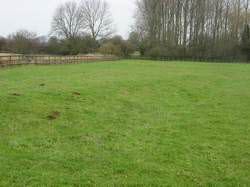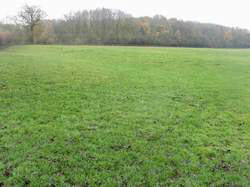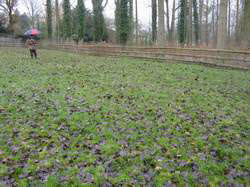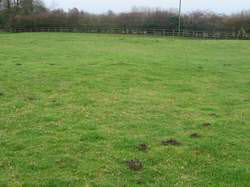Abandoned Communities ..... The Black Death
At Tilgarsley and Tusmore the inhabitants would have suffered great anxiety on learning that the pestilence had come into England, and there would have been enormous confusion and distress when it reached their villages. Before looking at the evidence indicating that both villages were completely destroyed we will consider other documentary records that tell us something about their population and relative level of prosperity.
Both villages were listed in the Rotuli Hundredorum, the tenurial survey ordered by Edward I in 1279. 50 tenants were listed under Tilgarsley, but it is thought that this entry includes Eynsham as well as Tilgarsley itself. As far as Tusmore is concerned, the secondary sources I have consulted are confusing and inconsistent, but Miles and Rowley are at least brief. They state that there were 19 tenants with the rector being the only freeholder. Perhaps one day I will have an opportunity to look at the original Rotuli Hundredorum and see what it actually says.
Miles D and Rowley T, Tusmore Deserted Village, Oxoniensia, 1976, 4, 309-315.
Moving on to 1327 it is then possible to use the information in the Nomina Villarum. Compiled by officials of the Exchequer for taxation purposes, it recorded the number of taxpayers and the total amount of tax due for each “vill”. At Tilgarsley the number of tax payers was 28 and the amount due was 85 shillings and eleven pence. At Tusmore the figures were 7 tax payers owing twelve shillings and eight pence.
The greater size and wealth of Tilgarsley are confirmed in records from 1334, when the Exchequer revised their estimate of the tax quota of each vill. On this occasion the quota for Tilgarsley was 94s 10d and at Tusmore it was 21s 6d.
In an “Occasional Paper” on the deserted villages of Oxfordshire Allison, Beresford and Hurst have analysed the 1334 tax assessments for the vills of Oxfordshire. They compared the data for all 314 vills with the data for 55 of those vills that were subsequently deserted for whatever reason. In general less wealthy vills were more likely to be abandoned. The median tax assessment for vills later deserted was 35s 2d whereas for all the vills it was 61s. Clearly Tusmore was one of the smaller and less prosperous vills that may have been vulnerable to depopulation. Tilgarsley, on the other hand, was one of the larger vills in the county. We have to assume that the Black Death was especially destructive at Tilgarsley.
Allison K J, Beresford M W, Hurst J G, The Deserted Villages of Oxfordshire, Leicester University Press, 1965.
How do we know that Tilgarsley and Tusmore were destroyed by the Black Death? In 1354 Tusmore was not taxed at all because of the severity of the pestilence. Then in 1357 the landowner, Roger de Cottisford was given permission to divert the road that ran through the village as the village was now void of inhabitants: De hameletto de Toresmere pertinent. ad Rog. de Cottesford, ac via inter Cotteford et Sulthorn inclusa, et licentia ad includend. dictum hamelettum. It is likely that Roger de Cottisford, having built a new road, turned the village and the land surrounding it into a large park, the forerunner of the Tusmore Estate that exists today. Finally, from 1358 there is a writ that refers to the death from pestilence of the bondmen from Roger de Cottisford’s fee and again implies that the whole village was empty.
Both villages were listed in the Rotuli Hundredorum, the tenurial survey ordered by Edward I in 1279. 50 tenants were listed under Tilgarsley, but it is thought that this entry includes Eynsham as well as Tilgarsley itself. As far as Tusmore is concerned, the secondary sources I have consulted are confusing and inconsistent, but Miles and Rowley are at least brief. They state that there were 19 tenants with the rector being the only freeholder. Perhaps one day I will have an opportunity to look at the original Rotuli Hundredorum and see what it actually says.
Miles D and Rowley T, Tusmore Deserted Village, Oxoniensia, 1976, 4, 309-
Moving on to 1327 it is then possible to use the information in the Nomina Villarum. Compiled by officials of the Exchequer for taxation purposes, it recorded the number of taxpayers and the total amount of tax due for each “vill”. At Tilgarsley the number of tax payers was 28 and the amount due was 85 shillings and eleven pence. At Tusmore the figures were 7 tax payers owing twelve shillings and eight pence.
The greater size and wealth of Tilgarsley are confirmed in records from 1334, when the Exchequer revised their estimate of the tax quota of each vill. On this occasion the quota for Tilgarsley was 94s 10d and at Tusmore it was 21s 6d.
In an “Occasional Paper” on the deserted villages of Oxfordshire Allison, Beresford and Hurst have analysed the 1334 tax assessments for the vills of Oxfordshire. They compared the data for all 314 vills with the data for 55 of those vills that were subsequently deserted for whatever reason. In general less wealthy vills were more likely to be abandoned. The median tax assessment for vills later deserted was 35s 2d whereas for all the vills it was 61s. Clearly Tusmore was one of the smaller and less prosperous vills that may have been vulnerable to depopulation. Tilgarsley, on the other hand, was one of the larger vills in the county. We have to assume that the Black Death was especially destructive at Tilgarsley.
Allison K J, Beresford M W, Hurst J G, The Deserted Villages of Oxfordshire, Leicester University Press, 1965.
How do we know that Tilgarsley and Tusmore were destroyed by the Black Death? In 1354 Tusmore was not taxed at all because of the severity of the pestilence. Then in 1357 the landowner, Roger de Cottisford was given permission to divert the road that ran through the village as the village was now void of inhabitants: De hameletto de Toresmere pertinent. ad Rog. de Cottesford, ac via inter Cotteford et Sulthorn inclusa, et licentia ad includend. dictum hamelettum. It is likely that Roger de Cottisford, having built a new road, turned the village and the land surrounding it into a large park, the forerunner of the Tusmore Estate that exists today. Finally, from 1358 there is a writ that refers to the death from pestilence of the bondmen from Roger de Cottisford’s fee and again implies that the whole village was empty.
Two
Part of a row of crofts on the southern edge of the village of Tusmore
A holloway where the main street through Tusmore probably ran
A house platform at Tusmore. The elderly but fit person in the photograph is my colleague John Hall.
Possible location of the church at Tusmore



